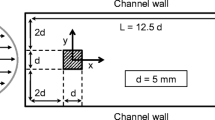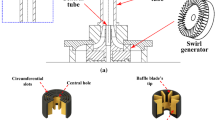Abstract
The effects of a stabilizer and the annular co-flow air speed on turbulent nonpremixed methane flames stabilized downstream of a conical bluff body were investigated. Four bluff body variants were designed by changing the outer diameter of a conically shaped object. The co-flow velocity was varied from zero to 7.4 m/s, while the fuel velocity was kept constant at 15 m/s. Radial distributions of temperature and velocity were measured in detail in the recirculation zone at vertical locations of 0.5D, 1D and 1.5D. Measurements also included the CO2, CO, NOx and O2 emissions at points downstream of the recirculation region. Flames were visualized under 20 different conditions, revealing various modes of combustion. The results evidenced that not only the co-flow velocity but also the bluff body diameter play important roles in the structure of the recirculation zone and, hence, the flame behavior.















Similar content being viewed by others
Abbreviations
- d :
-
Fuel pipe external diameter [mm]
- d f :
-
Fuel pipe internal diameter [mm]
- e :
-
Fuel exit plane
- D :
-
Bluff body diameter [mm]
- H :
-
Bluff body height [mm]
- r :
-
Location on the radial axis [mm]
- T :
-
Temperature [K]
- U f :
-
Fuel velocity [m/s]
- U cf :
-
Co-flow air velocity [m/s]
- U e :
-
Velocity at the fuel exit plane [m/s]
- U z :
-
Longitudinal Velocity [m/s]
- z :
-
Location on the longitudinal axis [mm]
- Øair :
-
Diameter of the air pipe
- BB:
-
Bluff body
- TC:
-
Thermocouple
References
European Commission (2013) Ecodesign requirements for space heaters and combination heaters. Commission regulation (EU) No 813/2013
Poinsot T, Veynante D (2001) Theoretical and numerical combustion. R.T. Edwards Inc., Philadelphia, pp 214–215
Peters N (1992) Fifteen lectures on laminar and turbulent combustion. Ercoftac Summer School, September 14-28
Turns SR (2000) An introduction to combustion concepts and applications second edition. McGraw-Hill, Singapore, pp 18–24
Peters N (2002) Turbulent combustion. Cambridge University Press, Cambridge, pp 170–172
Günther R, Wittmer V (1981) The turbulent reaction field in a concentric diffusion flame. Eighteenth Symposium (International) on Combustion 18:961–967. https://doi.org/10.1016/s0082-0784(81)80100-2
Basu P, Kefa C, Jestin L (2000) Boilers and burners design and theory. Springer-Verlag, New York, pp 108–118
Baukal CEJ (2000) Heat transfer in industrial combustion. CRC Press LLC, Florida, pp 8–21
Dally BB, Masri AR (1996) Turbulent nonpremixed flames stabilised on a bluff-body burner. Proceedings of the International Workshop on Measurement and Computation of Turbulent Nonpremixed Flames 1:47–52
Masri AR (1998) Computation of bluff-body stabilised jets and flames. Proceedings of the Third International Workshop on Measurement and Computation of Turbulent Nonpremixed Flames, Section 4:1–21
Kalt PAM, Masri AR (2002) Bluff-body stabilised jets and flames, Sixth International Workshop on Measurement and Computation of Turbulent Nonpremixed Flames, 137-171
Dally BB, Fletcher DF, Masri AR (1998) Flow and mixing fields of turbulent bluff-body jets and flames. Combust Theor Model 2(2):193–219. https://doi.org/10.1088/1364-7830/2/2/006
Kundu KM, Banerjee D, Bhaduri D (1980) On flame stabilization by bluff-bodies. J Eng Power-T Asme 102(1):209–214. https://doi.org/10.1115/1.3230225
Guo P, Zang S, Ge B (2010, May) Technical brief: predictions of flow field for circular-disk bluff-body stabilized flame investigated by large Eddy simulation and experiments. J Eng Gas Turbines Power 132:1–6. https://doi.org/10.1115/1.3205029
Chen YC, Chang CC, Pan KL, Yang JT (1998) Flame lift-off and stabilization mechanisms of nonpremixed jet flames on a bluff-body burner. Combust Flame 115(1–2):51–65. https://doi.org/10.1016/s0010-2180(97)00336-2
Mishra DP, Kiran DY (2009) Experimental studies of bluff-body stabilized LPG diffusion flames. Fuel 88(3):573–578. https://doi.org/10.1016/j.fuel.2008.09.027
Correa SM, Gulati A (1992) Measurements and modeling of a bluff body stabilized flame. Combust Flame 89(2):195–213. https://doi.org/10.1016/0010-2180(92)90028-n
Namazian M, Kelly J, Schefer RW (1992) Concentration imaging measurements in turbulent concentric-jet flows. AIAA J 30(2):384–394. https://doi.org/10.2514/6.1989-58
Schefer RW, Namazian M, Kelly J (1994) Velocity measurements in turbulent bluff-body stabilized flows. AIAA J 32(9):1844–1851. https://doi.org/10.2514/3.12182
Schefer RW, Namazian M, Kelly J (1987) Velocity measurements in a turbulent nonpremixed bluff-body stabilized flame. Combust Sci Technol 56(4–6):101–138. https://doi.org/10.1080/00102208708947084
Roquemore WM, Tankin RS, Chiu HH, Lottes SA (1986) A study of a bluff-body combustor using laser sheet lighting. Combust Sci Technol 4(4):205–213. https://doi.org/10.1007/bf00717816
Masri AR, Kelman JB, Dally BB (1998) The instantaneous spatial structure of the recirculation zone in bluff-body stabilized flames. Twenty-Seventh Symposium (International) on Combustion 27:1031–1038. https://doi.org/10.1016/s0082-0784(98)80503-1
Masri AR, Dibble RW, Barlow RS (1996) The structure of turbulent nonpremixed flames revealed by Raman-Rayleigh-LIF measurements. Prog Energ Combust 22:307–362. https://doi.org/10.1016/s0360-1285(96)00009-3
Masri AR, Dally BB, Barlow RS, Carter CD (1994) The structure of the recirculation zone of a bluff-body combustor. Twenty-Fifth Symposium (International) on Combustion/The Combustion Institute 1301-1308. https://doi.org/10.1016/s0082-0784(06)80771-x
Ozdemir IB (2018) A modification to temperature-composition pdf method and its application to the simulation of a transitional bluff-body flame. Comput Math Appl 75(7):2574–2592. https://doi.org/10.1016/j.camwa.2017.12.031
Yang JT, Chang CC, Pan KL (2002) Flow structures and mixing mechanisms behind a disc stabilizer with a central fuel jet. Combust Sci Technol 174(3):93–124. https://doi.org/10.1080/713712993
Ma HK, Harn JS (1994) The jet mixing effect on reaction flow in a bluff-body burner. Int J Heat Mass Transf 37(18):2957–2967. https://doi.org/10.1016/0017-9310(94)90350-6
Huang RF, Lin CL (1994) Characteristic modes and thermal structure of nonpremixed circular-disc stabilized flames. Combust Sci Technol 100(1–6):123–139. https://doi.org/10.1080/00102209408935449
Huang RF, Lin CL (2000) Velocity fields of nonpremixed bluff-body stabilized flames. J Energ Resour ASME 122(2):88–93. https://doi.org/10.1115/1.483166
Yang JT, Chang CC, Pan KL, Kang YP, Lee YP (2002) Thermal analysis and PLIF imaging of reacting flow behind a disc stabilizer with a central fuel jet. Combust Sci Technol 174(3):71–92. https://doi.org/10.1080/713712996
Esquiva-Dano I, Nguyen HT, Escudié D (2001) Influence of a bluff-body's shape on the stabilization regime of non-premixed flames. Combust Flame 127(4):2167–2180. https://doi.org/10.1016/s0010-2180(01)00318-2
Esquiva-Dano I, Escudié D (2005) A way of considering the influence of the bluff-body geometry on the nonpremixed flame stabilization process. Combust Flame 142(3):299–302. https://doi.org/10.1016/j.combustflame.2004.10.001
Kimoto K, Shiraishi I, Matsumoto R (1981) Structure of turbulent jet flames stabilized in annular air jet. Combust Sci Technol 25(1–2):31–41. https://doi.org/10.1080/00102208108547519
Taylor AMKP, Whitelaw JH (1984) Velocity characteristics in the turbulent near wakes of confined axisymmetric bluff bodies. J Fluid Mech 139:391–416. https://doi.org/10.1017/S0022112084000410
Tang H, Yang D, Zhang T, Zhu M (2013) Characteristics of flame modes for a conical bluff body burner with a central fuel jet. J Eng Gas Turbines Power 135(9):091507. https://doi.org/10.1115/1.4024951
San KC, Huang YZ, Yen SC (2013) Flame patterns and combustion intensity behind rifled bluff-body frustums. J Eng Gas Turbines Power 135(12):121502. https://doi.org/10.1115/1.4025262
Huang RF, Kivindu RM, Hsu CM (2017) Flame behavior and thermal structure of combusting plane jets with and without self-excited transverse oscillations. Heat Mass Transf 54:1681. https://doi.org/10.1007/s00231-017-2268-0
Tong Y, Liu X, Chen S, Li Z, Klingmann J (2018) Effects of the position of a bluff-body on the diffusion flames: a combined experimental and numerical study. Appl Therm Eng 131:507–521. https://doi.org/10.1016/j.applthermaleng.2017.12.031
Tong Y, Li M, Klingmann J, Chen S, Li Z (2017) Experimental investigation on the influences of bluff-body's position on diffusion flame structures. Asme Power Conference. https://doi.org/10.1115/power-icope2017-3090
Snegirev A, Markus E, Kuznetsov E (2018) On soot and radiation modeling in buoyant turbulent diffusion flames. Heat Mass Transf 54:2275. https://doi.org/10.1007/s00231-017-2198-x
Gendy TS, El-Shiekh TM, Zakhary AS (2015) A polynomial regression model for stabilized turbulent confined jet diffusion flames using bluff body burners. Egypt J Pet 24:445–453. https://doi.org/10.1016/j.ejpe.2015.06.001
Mishra DP, Kumar P (2010) Experimental study of bluff-body stabilized LPG–H2 jet diffusion flame with preheated reactant. Fuel 89(1):212–218. https://doi.org/10.1016/j.fuel.2009.07.030
Kumar P, Mishra DP (2008) Effects of bluff-body shape on LPG–H2 jet diffusion flame. Int J Hydrogen Energ 33(10):2578–2585. https://doi.org/10.1016/j.ijhydene.2008.02.075
Yen SC, Shih CL, San KC (2017) Non-premixed flame characteristics and exhaust gas concentrations behind rifled bluff-body cones. J Energy Inst 91(4):489–501. https://doi.org/10.1016/j.joei.2017.04.008
Yen SC, Huang YZ, San KC (2015) Thermal characteristics and exhaust-gas analysis behind bluff-body frustums. Fuel 159:519–529. https://doi.org/10.1016/j.fuel.2015.07.021
Elbaz AM, Zayed MF, Samy M, Roberts WL, Mansour MS (2015) The flow field structure of highly stabilized partially premixed flames in a concentric flow conical nozzle burner with coflow. Exp Thermal Fluid Sci 73:2–9. https://doi.org/10.1016/j.expthermflusci.2015.08.016
Tong Y, Liu X, Wang Z, Richter M, Klingmann J (2018) Experimental and numerical study on bluff-body and swirl stabilized diffusion flames. Fuel 217:352–364. https://doi.org/10.1016/j.fuel.2017.12.061
Dutka M, Ditaranto M, Løvås T (2016) NOx emissions and turbulent flow field in a partially premixed bluff body burner with CH4 and H2 fuels. Int J Hydrogen Energ 41(28):12397–12410. https://doi.org/10.1016/j.ijhydene.2016.05.154
Driscoll JF, Chen RH, Yoon Y (1992) Nitric oxide levels of turbulent jet diffusion flames: effects of residence time and Damkohler number. Combust Flame 88:37–49. https://doi.org/10.1016/0010-2180(92)90005-a
Glassman I (1977) Combustion. Academic Press Inc., New York, pp 210–226
Author information
Authors and Affiliations
Corresponding author
Ethics declarations
Conflict of interest
On behalf of all authors, the corresponding author states that there is no conflict of interest.
Additional information
Publisher’s note
Springer Nature remains neutral with regard to jurisdictional claims in published maps and institutional affiliations.
Rights and permissions
About this article
Cite this article
Ata, A., Ozdemir, I.B. Effects of the cone angle on the stability of turbulent nonpremixed flames downstream of a conical bluff body. Heat Mass Transfer 56, 1627–1639 (2020). https://doi.org/10.1007/s00231-019-02789-6
Received:
Accepted:
Published:
Issue Date:
DOI: https://doi.org/10.1007/s00231-019-02789-6




